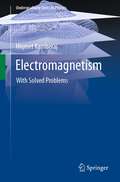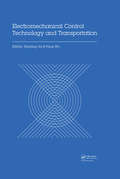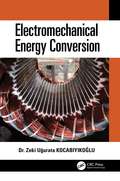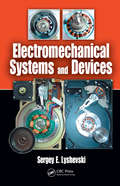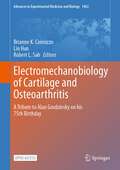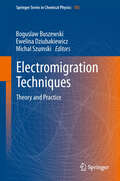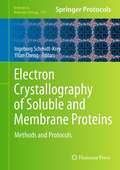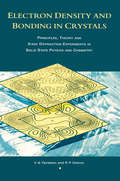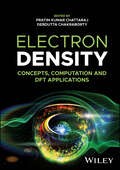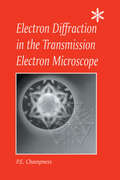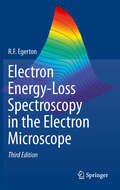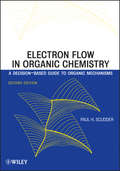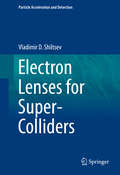- Table View
- List View
Electromagnetism: Maxwell Equations, Wave Propagation and Emission (Wiley-iste Ser.)
by Tamer BecherrawyThis book deals with electromagnetic theory and its applications at the level of a senior-level undergraduate course for science and engineering. The basic concepts and mathematical analysis are clearly developed and the important applications are analyzed. Each chapter contains numerous problems ranging in difficulty from simple applications to challenging. The answers for the problems are given at the end of the book. Some chapters which open doors to more advanced topics, such as wave theory, special relativity, emission of radiation by charges and antennas, are included. The material of this book allows flexibility in the choice of the topics covered. Knowledge of basic calculus (vectors, differential equations and integration) and general physics is assumed. The required mathematical techniques are gradually introduced. After a detailed revision of time-independent phenomena in electrostatics and magnetism in vacuum, the electric and magnetic properties of matter are discussed. Induction, Maxwell equations and electromagnetic waves, their reflection, refraction, interference and diffraction are also studied in some detail. Four additional topics are introduced: guided waves, relativistic electrodynamics, particles in an electromagnetic field and emission of radiation. A useful appendix on mathematics, units and physical constants is included. Contents 1. Prologue. 2. Electrostatics in Vacuum. 3. Conductors and Currents. 4. Dielectrics. 5. Special Techniques and Approximation Methods. 6. Magnetic Field in Vacuum. 7. Magnetism in Matter. 8. Induction. 9. Maxwell’s Equations. 10. Electromagnetic Waves. 11. Reflection, Interference, Diffraction and Diffusion. 12. Guided Waves. 13. Special Relativity and Electrodynamics. 14. Motion of Charged Particles in an Electromagnetic Field. 15. Emission of Radiation.
Electromagnetism: With Solved Problems (Undergraduate Texts in Physics)
by Hiqmet KamberajAny curriculum involving science and/or engineering will eventually find itself entering the realm of physics. This book seeks to introduce students to a number of the fundamental concepts in physics and illustrate how different theories were developed out of physical observations and phenomena. The book presents multi-chapter sections on electrostatics, magnetism and electromagnetic waves, with eyes on both the past and the future, touching, along the way, on Coulomb, Gauss, Maxwell, Ohm, Biot-Savart, Ampere, Faraday, Fresnel and Lorentz. The book also contains an appendix that provides the reader with a portion of the mathematical background of vector analysis and vector differential operators. The book approaches its topics through a focus on examples and problem-solving techniques, illustrating vividly how physical theories are applied to problems in engineering and science. The book is primarily aimed at undergraduate students in these two fields, but it also features chapters that are geared towards senior undergraduates working on their final year theses.
Electromechanical Control Technology and Transportation: Proceedings of the 2nd International Conference on Electromechanical Control Technology and Transportation (ICECTT 2017), January 14-15, 2017, Zhuhai, China
by Feng Wu Xiaoling JiaThe 2017 2nd International Conference on Electromechanical Control Technology and Transportation (ICECTT 2017) was held on January 14–15, 2017 in Zhuhai, China. ICECTT 2017 brought together academics and industrial experts in the field of electromechanical control technology and transportation to a common forum. The primary goal of the conference was to promote research and developmental activities in electromechanical control technology and transportation. Another goal was to promote exchange of scientific information between researchers, developers, engineers, students, and practitioners working all around the world. The conference will be held every year thus making it an ideal platform for people to share views and experiences in electromechanical control technology and transportation and related areas.
Electromechanical Energy Conversion
by Zeki Uğurata KocabiyikoğluThis book is intended to be a textbook for undergraduate students studying electrical and electronic engineering in universities and colleges. Therefore, the level and amount of the knowledge to be transferred to the reader is kept to as much as what can be taught in one academic semester of a university or a college course. Although the subject is rather classical and somehow well established in some respects, it is vast and can be difficult to grasp if unnecessary details are not avoided. This book is aimed to give the reader just what is necessary - with plenty of short and easily understandable examples and drawings, figures, and tables. A course on electromechanical energy conversion is a necessity in all universities and colleges entitled to grant a license for electrical engineering. This book is aimed at meeting the requirements of this essential subject by providing necessary information to complete the course. A compact chapter is included with figures and tables on energy and the restraints on its production brought about by global climate change. A new approach has been tried for some of the classic subjects including magnetic circuits and electrical machines together with today’s much-used motors.
Electromechanical Systems and Devices
by Sergey Edward LyshevskiStudents entering today's engineering fields will find an increased emphasis on practical analysis, design, and control. They must be able to translate their advanced programming abilities and sound theoretical backgrounds into superior problem-solving skills. Electromechanical Systems and Devices facilitates the creation of critical problem-solvin
Electromechanobiology of Cartilage and Osteoarthritis: A Tribute to Alan Grodzinsky on his 75th Birthday (Advances in Experimental Medicine and Biology #1402)
by Brianne K. Connizzo Lin Han Robert L. SahThis is an open access book. In honor of his 75th birthday, we reflect on the impact of the pioneering work of Alan Grodzinsky and his laboratory. This volume includes in-depth discussions of tissue electromechanics, mechanobiology and biomechanics, and matrix biology in addition to the latest advancements in understanding the pathogenesis, progression and treatment of osteoarthritis. Unique to this volume, we overview decades of groundbreaking research that set the stage for the latest efforts in the field, highlighting the legacy of one researcher and their trainees.
Electromigration Modeling at Circuit Layout Level
by Cher Ming Tan Feifei HeIntegrated circuit (IC) reliability is of increasing concern in present-day IC technology where the interconnect failures significantly increases the failure rate for ICs with decreasing interconnect dimension and increasing number of interconnect levels. Electromigration (EM) of interconnects has now become the dominant failure mechanism that determines the circuit reliability. This brief addresses the readers to the necessity of 3D real circuit modelling in order to evaluate the EM of interconnect system in ICs, and how they can create such models for their own applications. A 3-dimensional (3D) electro-thermo-structural model as opposed to the conventional current density based 2-dimensional (2D) models is presented at circuit-layout level.
Electromigration Techniques
by Michal Szumski Ewelina Dziubakiewicz Boguslaw BuszewskiThe book provides the broad knowledge on electromigration techniques including: theory of CE, description of instrumentation, theory and practice in micellar electrokinetic chromatography, isotachophoresis, capillary isoelectric focusing, capillary and planar electrochromatography (including description of instrumentation and packed and monolithic column preparation), 2D-gel electrophoresis (including sample preparation) and lab-on-a-chip systems. The book also provides the most recent examples of applications including food, environmental, pharmaceutical analysis as well as proteomics.
Electron Acceleration in the Aurora and Beyond
by D BryantHow did electrons in the high atmosphere and space around the Earth come to acquire their speeds and energies?This intriguing question lies at the heart of understanding how high-energy electrons create the spectacular displays of the ^IAurora Borealis and ^IAurora Australis. Electron Acceleration in the Aurora and Beyond explores the mysteries
Electron Backscatter Diffraction in Materials Science
by Brent L. Adams Mukul Kumar Adam J. Schwartz David P. FieldElectron backscatter diffraction is a very powerful and relatively new materials characterization technique aimed at the determination of crystallographic texture, grain boundary character distributions, lattice strain, phase identification, and much more. The purpose of this book is to provide the fundamental basis for electron backscatter diffraction in materials science, the current state of both hardware and software, and illustrative examples of the applications of electron backscatter diffraction to a wide-range of materials including undeformed and deformed metals and alloys, ceramics, and superconductors. The text has been substantially revised from the first edition, and the authors have kept the format as close as possible to the first edition text. The new developments covered in this book include a more comphrensive coverage of the fundamentals not covered in the first edition or other books in the field, the advances in hardware and software since the first edition was published, and current examples of application of electron backscatter diffraction to solve challenging problems in materials science and condensed-matter physics.
Electron Beam Wire Deposition Technology and Its Application (Additive Manufacturing Technology)
by Guang Yang Shuili Gong Jianrong Liu Haiying XuThis book provides a systematic and comprehensive introduction to the technical principles, materials, processes, and equipment of the electron beam wire deposition technology (EBWD), while focusing on the research results of the author’s scientific research team engaged in this technology in China. It mainly introduces the conceptual connotation, principle, and characteristics of the EBWD technology, its position and function in the additive manufacturing technology system, the direction and trend of technological development at home and abroad, the fundamentals and application results of the EBWD technology, including technical principles, equipment technology, special materials, manufacturing technology, quality testing, and application practices. So this book can serve as a reference book for teachers, students, and scientific researchers in scientific research institutions who are engaged in relevant studies.
Electron Correlation in Molecules
by S. WilsonElectron correlation effects are of vital significance to the calculation of potential energy curves and surfaces, the study of molecular excitation processes, and in the theory of electron-molecule scattering. This text describes methods for addressing one of theoretical chemistry's central problems, the study of electron correlation effects in molecules.Although the energy associated with electron correlation is a small fraction of the total energy of an atom or molecule, it is of the same order of magnitude as most energies of chemical interest. If the solution of quantum mechanical equations from first principles is to provide an accurate quantitative prediction, reliable techniques for the theoretical determination of the effect of electron correlation on molecular properties are therefore important. To that end, this text explores molecular electronic structure, independent electron models, electron correlation, the linked diagram theorem, group theoretical aspects, the algebraic approximation, and truncation of expansions for expectation values.
Electron Crystallography of Soluble and Membrane Proteins
by Ingeborg Schmidt-Krey Yifan ChengThe basic principle of electron crystallography is to calculate a 3D density map by combining the amplitudes obtained from electron diffraction patterns with the experimental phases calculated from images of two-dimensional crystals of membrane or soluble proteins. This technology is very well developed and has produced a number of atomic models of membrane proteins in a lipid environment. Focused on comprehensive experimental protocols, Electron Crystallography of Soluble and Membrane Proteins: Methods and Protocols covers the entire range of techniques used in electron crystallography, including protein sample preparation, 2D crystallization, and screening in negative stain over electron cryo-microscopy (cryo-EM) and data processing, as well as modeling of conformational changes. Additional chapters provide perspective on past, present, and future challenges as well as complementary methods. Written for the popular Methods in Molecular BiologyTM series, the work contains the kind of detailed descriptions and implementation advice necessary to ensure successful results. Comprehensive and cutting-edge, Electron Crystallography of Soluble and Membrane Proteins: Methods and Protocols serves laboratories new to the methods as well as state-of-the-art facilities pursuing this exciting area of protein science.
Electron Cyclotron Resonance Ion Sources and ECR Plasmas
by R GellerAcknowledged as the "founding father" of and world renowned expert on electron cyclotron resonance sources Richard Geller has produced a unique book devoted to the physics and technicalities of electron cyclotron resonance sources. Electron Cyclotron Resonance Ion Sources and ECR Plasmas provides a primer on electron cyclotron phenomena in ion sour
Electron Density and Bonding in Crystals: Principles, Theory and X-ray Diffraction Experiments in Solid State Physics and Chemistry
by V.G Tsirelson R.P OzerovElectron Density and Bonding in Crystals: Principles, Theory and X-Ray Diffraction Experiments in Solid State Physics and Chemistry provides a comprehensive, unified account of the use of diffraction techniques to determine the distribution of electrons in crystals. The book discusses theoretical and practical techniques, the application of electron density studies to chemical bonding, and the determination of the physical properties of condensed matter.The book features the authors' own key contributions to the subject as well a thorough, critical summary of the extensive literature on electron density and bonding. Logically organized, coverage ranges from the theoretical and experimental basis of electron density determination to its impact on investigations of the nature of the chemical bond and its uses in determining electromagnetic and optical properties of crystals. The main text is supplemented by appendices that provide clear, concise guidance on aspects such as systems of units, quantum theory of atomic vibrations, atomic orbitals, and creation and annihilation operators. The result is a valuable compendium of modern knowledge on electron density distributions, making this reference a standard for crystallographers, condensed matter physicists, theoretical chemists, and materials scientists.
Electron Density and Chemical Bonding I
by Dietmar StalkeD. Stalke, U. Flierler: More than Just Distances from Electron Density Studies.- A.O. Madsen: Modeling and Analysis of Hydrogen Atoms.- B.B. Iversen/J. Overgaard: Charge Density Methods in Hydrogen Bond Studies.- U. Flierler, D. Stalke: Some Main Group Chemical Perceptions in the Light of Experimental Charge Density Investigations.- D. Leusser: Electronic Structure and Chemical Properties of Lithium Organics Seen Through the Glasses of Charge Density.- L. J. Farrugia, P. Macchi: Bond Orders in Metal-Metal Interactions Through Electron Density Analysis.- W. Scherer, V. Herz, Ch. Hauf: On the Nature of β-Agostic Interactions: A Comparison Between the Molecular Orbital and Charge Density Picture.
Electron Density: Concepts, Computation and DFT Applications
by Pratim Kumar Chattaraj Debdutta ChakrabortyDiscover theoretical, methodological, and applied perspectives on electron density studies and density functional theory Electron density or the single particle density is a 3D function even for a many-electron system. Electron density contains all information regarding the ground state and also about some excited states of an atom or a molecule. All the properties can be written as functionals of electron density, and the energy attains its minimum value for the true density. It has been used as the basis for a quantum chemical computational method called Density Functional Theory, or DFT, which can be used to determine various properties of molecules. DFT brings out a drastic reduction in computational cost due to its reduced dimensionality. Thus, DFT is considered to be the workhorse for modern computational chemistry, physics as well as materials science. Electron Density: Concepts, Computation and DFT Applications offers an introduction to the foundations and applications of electron density studies and analysis. Beginning with an overview of major methodological and conceptual issues in electron density, it analyzes DFT and its major successful applications. The result is a state-of-the-art reference for a vital tool in a range of experimental sciences. Readers will also find: A balance of fundamentals and applications to facilitate use by both theoretical and computational scientists Detailed discussion of topics including the Levy-Perdew-Sahni equation, the Kohn Sham Inversion problem, and more Analysis of DFT applications including the determination of structural, magnetic, and electronic properties Electron Density: Concepts, Computation and DFT Applications is ideal for academic researchers in quantum, theoretical, and computational chemistry and physics.
Electron Diffraction in the Transmission Electron Microscope: Electron Diffraction in the Transmission Electron Microscope
by P.E. ChampnessThis book is a practical guide to electron diffraction in the transmission electron microscope (TEM). Case studies and examples are used to provide an invaluable introduction to the subject for those new to the technique. The book explains the basic methods used to obtain diffraction patterns with the TEM. The numerous illustrations aid the understanding of the conclusions reached.
Electron Energy Loss Spectroscopy (Microscopy Handbooks)
by R. BrydsonElectron Energy Loss Spectroscopy (EELS) is a high resolution technique used for the analysis of thin samples of material. The technique is used in many modern transmission electron microscopes to characterise materials. This book provides an up-to-date introduction to the principles and applications of EELS. Specific topics covered include, theory of EELS, elemental quantification, EELS fine structure, EELS imaging and advanced techniques.
Electron Energy-Loss Spectroscopy in the Electron Microscope
by R. F. EgertonWithin the last 30 years, electron energy-loss spectroscopy (EELS) has become a standard analytical technique used in the transmission electron microscope to extract chemical and structural information down to the atomic level. In two previous editions, Electron Energy-Loss Spectroscopy in the Electron Microscope has become the standard reference guide to the instrumentation, physics and procedures involved, and the kind of results obtainable. Within the last few years, the commercial availability of lens-aberration correctors and electron-beam monochromators has further increased the spatial and energy resolution of EELS. This thoroughly updated and revised Third Edition incorporates these new developments, as well as advances in electron-scattering theory, spectral and image processing, and recent applications in fields such as nanotechnology. The appendices now contain a listing of inelastic mean free paths and a description of more than 20 MATLAB programs for calculating EELS data.
Electron Flow in Organic Chemistry
by Paul H. ScudderSets forth the analytical tools needed to solve key problems in organic chemistryWith its acclaimed decision-based approach, Electron Flow in Organic Chemistry enables readers to develop the essential critical thinking skills needed to analyze and solve problems in organic chemistry, from the simple to complex. The author breaks down common mechanistic organic processes into their basic units to explain the core electron flow pathways that underlie these processes. Moreover, the text stresses the use of analytical tools such as flow charts, correlation matrices, and energy surfaces to enable readers new to organic chemistry to grasp the fundamentals at a much deeper level.This Second Edition of Electron Flow in Organic Chemistry has been thoroughly revised, reorganized, and streamlined in response to feedback from both students and instructors. Readers will find more flowcharts, correlation matrices, and algorithms that illustrate key decision-making processes step by step. There are new examples from the field of biochemistry, making the text more relevant to a broader range of readers in chemistry, biology, and medicine. This edition also offers three new chapters:Proton transfer and the principles of stabilityImportant reaction archetypesQualitative molecular orbital theory and pericyclic reactionsThe text's appendix features a variety of helpful tools, including a general bibliography, quick-reference charts and tables, pathway summaries, and a major decisions guide.With its emphasis on logical processes rather than memorization to solve mechanistic problems, this text gives readers a solid foundation to approach and solve any problem in organic chemistry.
Electron Flow in Organic Chemistry: A Decision-Based Guide to Organic Mechanisms
by Paul H. ScudderElectron Flow in Organic Chemistry Teaches students to solve problems in Organic Chemistry using methods of analysis that are valuable and portable to other fields Electron Flow in Organic Chemistry provides a unique decision-based approach that develops a chemical intuition based on a crosschecked analysis process. Assuming only a general background in chemistry, this acclaimed textbook teaches students how to write reasonable reaction mechanisms and use analytical tools to solve both simple and complex problems in organic chemistry. As in previous editions, the author breaks down challenging organic mechanisms into a limited number of core elemental mechanistic processes, the electron flow pathways, to explain all organic reactions—using flow charts as decision maps, energy surfaces as problem space maps, and correlation matrices to display all possible interactions. The third edition features entirely new chapters on crosschecking chemical reactions through good mechanistic thinking and solving spectral analysis problems using organic structure elucidation strategies. This edition also includes more biochemical reaction mechanism examples, additional exercises with answers, expanded discussion of how general chemistry concepts can show that structure determines reactivity, and new appendix covering transition metal organometallics. Emphasizing critical thinking rather than memorization to solve mechanistic problems, this popular textbook: Features new and expanded material throughout, including more flowcharts, correlation matrices, energy surfaces, and algorithms that illustrate key decision-making processes Provides examples from the field of biochemistry of relevance to students in chemistry, biology, and medicine Incorporates principles from computer science and artificial intelligence to teach decision-making processes Contains a general bibliography, quick-reference charts and tables, pathway summaries, a major decisions guide, and other helpful tools Offers material for instructors including a solutions manual, supplemental exercises with detailed answers for each chapter usable as an exam file, and additional online resources Electron Flow in Organic Chemistry: A Decision-Based Guide to Organic Mechanisms, Third Edition, is the perfect primary textbook for advanced undergraduate or beginning graduate courses in organic reaction mechanisms, and an excellent supplement for graduate courses in physical organic chemistry, enzymatic reaction mechanisms, and biochemistry.
Electron Gun for Gyrotrons (SpringerBriefs in Applied Sciences and Technology)
by Udaybir Singh A. K. SinhaThis book highlights the emission, transmission, and launching of an electron beam. It presents an overview and recent advances in order to enhance knowledge in the field of gyrotron in general and electron gun in particular. The book is presented in seven chapters starting with the introduction and ending with future possible directions in the field of electron beams and gyrotrons.
Electron Holography for Electromagnetic Materials (Springer Series in Materials Science #347)
by Daisuke Shindo Zentaro AkaseThis book discusses the direct imaging of electric and magnetic fields of various functional materials using electron holography, providing indispensable information for understanding their electromagnetic properties. In order to clearly demonstrate the principles of this cutting-edge technology, easy-to-understand explanations are accompanied by numerous illustrations and figures throughout the book. The book highlights the dynamic nature of electromagnetic fields in novel materials, as revealed by changing temperature, or applying electric current and magnetic fields. Furthermore, it showcases, as a new development of the technique, the direct observation of accumulation and collective motion of electrons around charged insulators. Clear experimental data on electromagnetic fields and the motions of electrons help the reader understand their importance in materials science and fundamental physics. Seeing is believing!
Electron Lenses for Super-Colliders
by Vladimir D. ShiltsevThis book provides a comprehensive overview of the operating principles and technology of electron lenses in supercolliders. Electron lenses are a novel instrument for high energy particle accelerators, particularly for the energy-frontier superconducting hadron colliders, including the Tevatron, RHIC, LHC and future very large hadron colliders. After reviewing the issues surrounding beam dynamics in supercolliders, the book offers an introduction to the electron lens method and its application. Further chapters describe the technology behind the electron lenses which have recently been proposed, built and employed for compensation of beam-beam effects and for collimation of high-energy high-intensity beams, for compensation of space-charge effects and several other applications in accelerators. The book will be an invaluable resource for those involved in the design, construction and operation of the next generation of hadron colliders.

